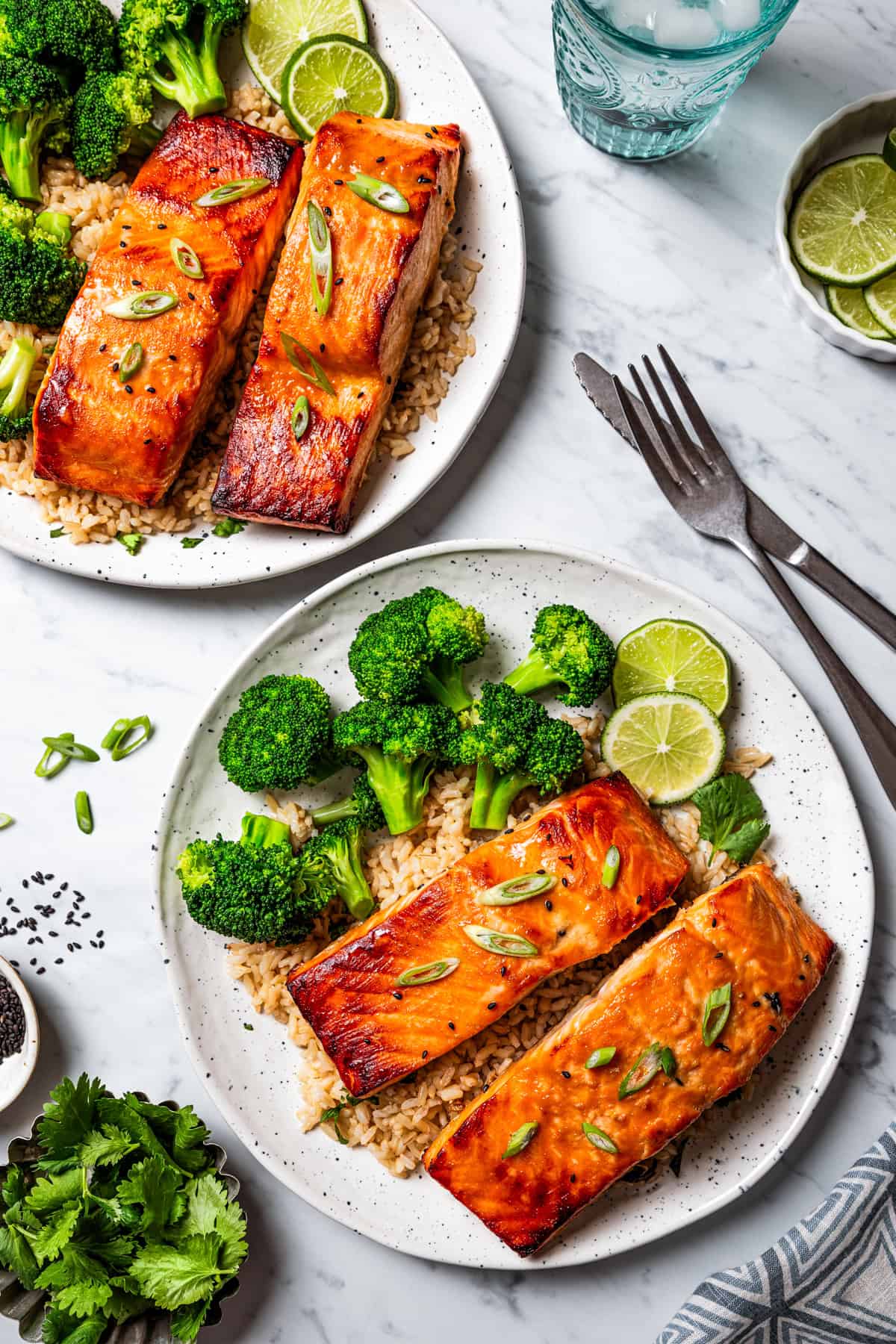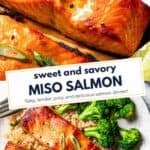This sweet and savory miso salmon is marinated in a flavor-packed miso glaze that caramelizes in the oven while the salmon bakes up tender and flaky. It’s one of my favorite salmon dinners recently, and it’s so easy to make!
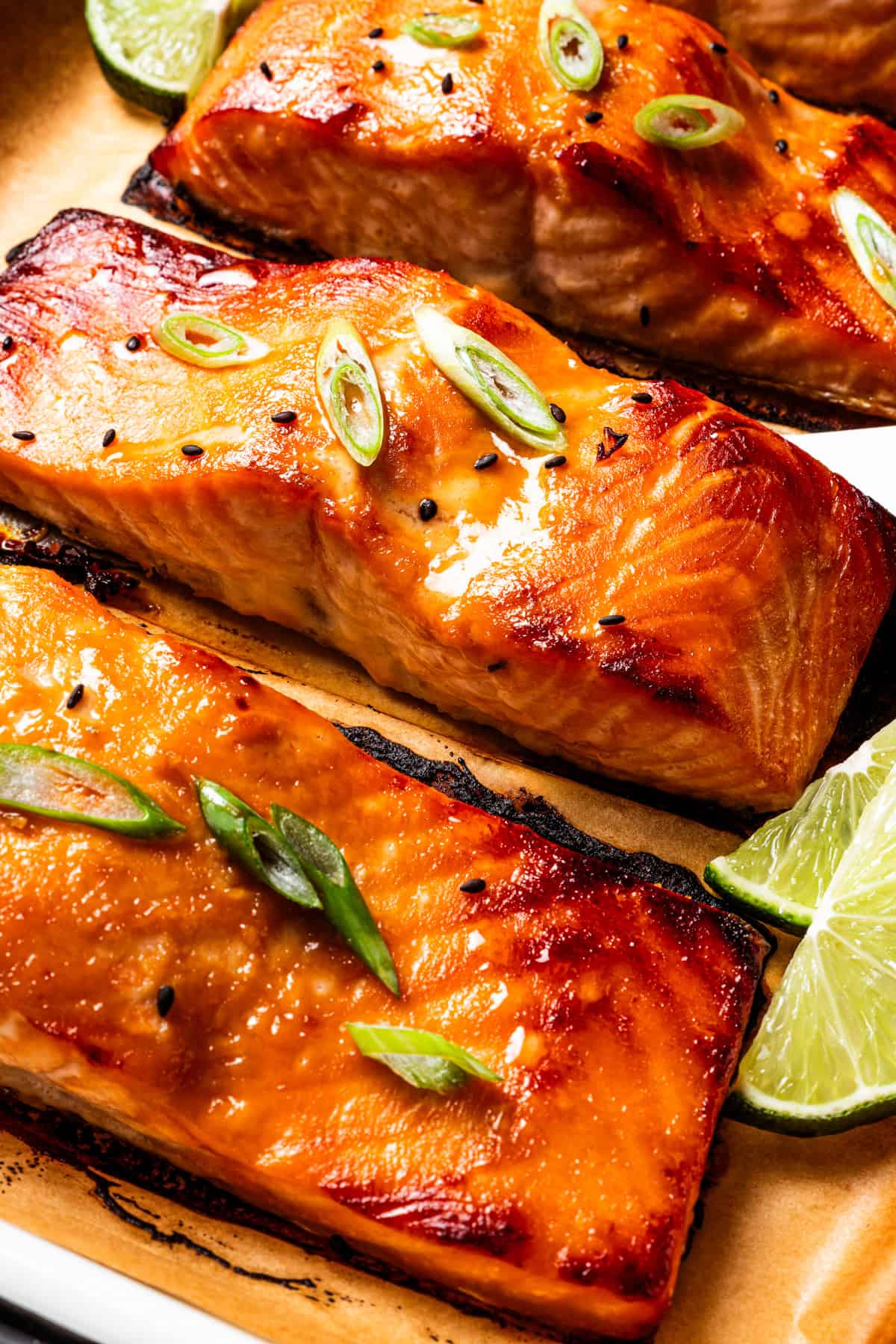
I’ve always been a fan of Asian cooking, whether it’s homemade hibachi, Japanese-style chicken katsu, or maki rolls. And, if you’ve been here a while, you’ll know I’m somewhat obsessed with salmon. So, you can probably understand why I’m so excited for you to try miso salmon! It’s a little savory, a little sweet, tender, and perfectly flaky.
Why This Miso Salmon Makes Miso Happy
- Super versatile glaze. The glaze in this recipe is a flavor-packed combination of miso, soy sauce, maple syrup, and sesame oil. It reminds me a lot of my teriyaki salmon, since it caramelizes on the salmon without overpowering the flavor. Plus, you can use it in more recipes, from chicken dishes to vegetables and stir-fries.
- Marinate the salmon ahead of time. Mix up the miso glaze and then leave the salmon to soak up the flavor for an hour. The salmon cooks quickly afterward, so I can spend the extra time prepping a tasty side dish, like rice or veggies.
- Bursting with umami. Sweet, savory, salty, earthy: There’s nothing quite like miso. If you’re new to this traditional Japanese ingredient, prepare to be hooked. It brings all sorts of richness and flavor to this miso salmon, and you can also use it in ramen, salad dressings, curries, and even desserts. More on this in a minute.
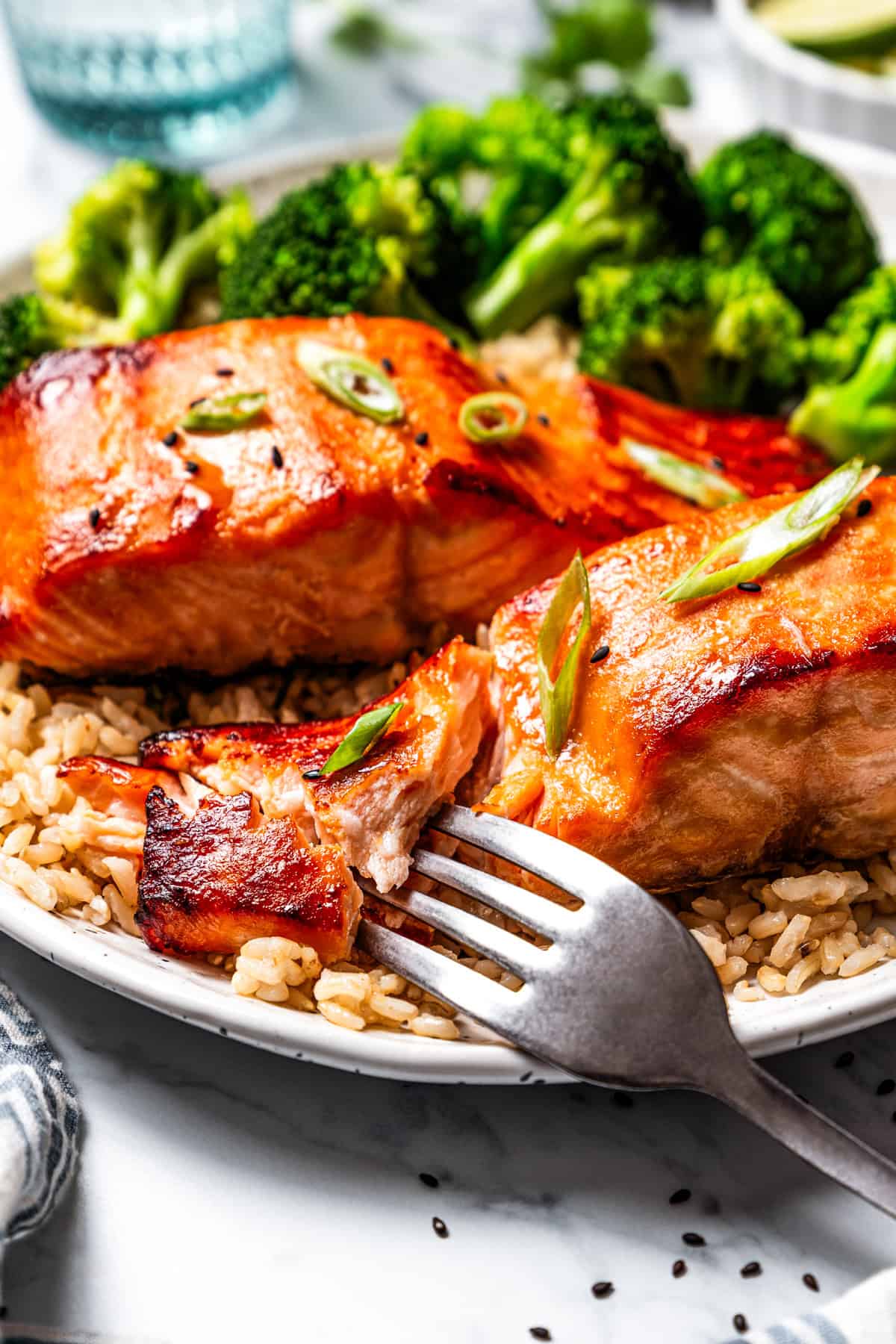
What Is Miso, and What Does It Taste Like?
If you’ve never cooked with it, you might be thinking, “What the heck is miso?” In short, miso is a fermented soybean paste. It comes from Japanese cuisine, and it has a distinctly sweet, savory umami flavor, a bit more complex than soy sauce or Worcestershire sauce.
You’ll find light colored miso, which is sweet and mild, and darker miso, which is richer and more concentrated. Which one you use really comes down to preference and how you’re using it. You’ll find two popular types of miso in stores:
- White (shiro) miso – White miso is the lightest and mildest form. It has a sweet, smooth, and nutty taste, so it’s a good option for dressings, light meats like chicken, or if you simply prefer a lighter flavor.
- Red (aka) miso – Red miso is richer, darker, and fermented longer than white miso, with a bolder flavor. I recommend red miso for marinating salmon, as it’s a stronger-flavored fish.
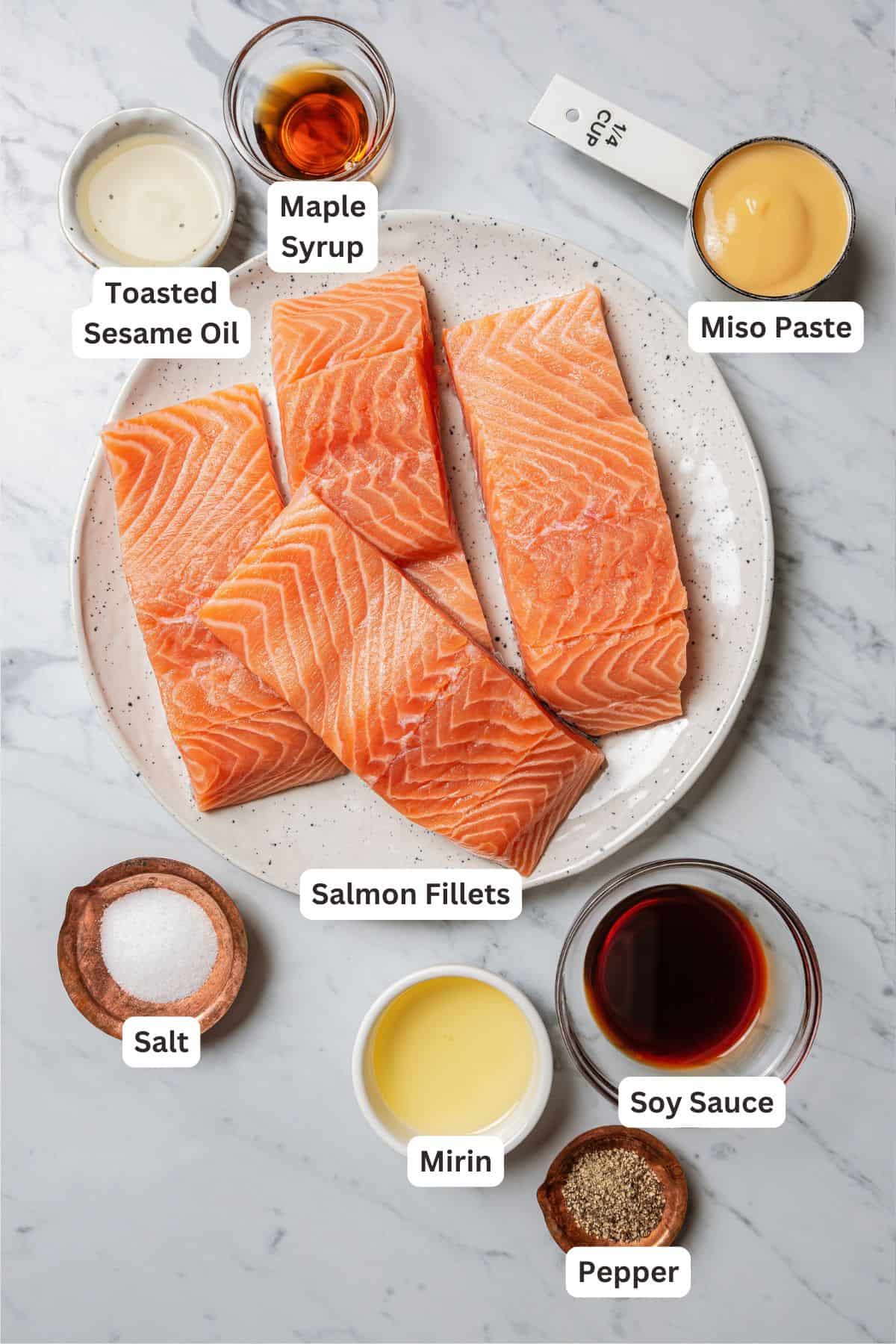
Ingredients You’ll Need
The better quality ingredients you use, the better your baked miso salmon will be. I’ve included some notes to guide you below. Scroll down to the recipe card after the post for the printable ingredients list with amounts, followed by step-by-step instructions with photos.
- Miso Paste – Not all miso pastes are the same quality, and it’s good to know what to look for when shopping for miso paste. I always buy naturally fermented red miso made from simple ingredients: soybeans, salt, and a grain (usually barley or rice). Natural miso also has a grainy texture. Cheaper miso is ultra-smooth, relies on faster fermentation, and contains additives, like sweeteners. IMO, it’s worth it to splurge on the real deal if you can.
- Mirin – Mirin is a type of Japanese rice wine used in cooking. If you don’t have mirin, good substitutes are dry sherry or rice vinegar mixed with a little sugar.
- Soy Sauce – I prefer low-sodium soy sauce, but regular soy sauce works, too.
- Maple Syrup – You can also use brown sugar.
- Sesame Oil – I like toasted sesame oil in this recipe. Plain sesame oil will also work. Unfortunately, there isn’t really a substitute for sesame oil flavor in Asian-style recipes. If you need to thin out your glaze, try using canola oil, peanut oil, or another vegetable oil, but the taste won’t be quite the same.
- Salmon Fillets – You can buy fillets pre-cut from the fish counter at the grocery store, or buy a whole salmon side and slice it into fillets at home. Try to use fillets that are similar in size (about 6 ounces each).
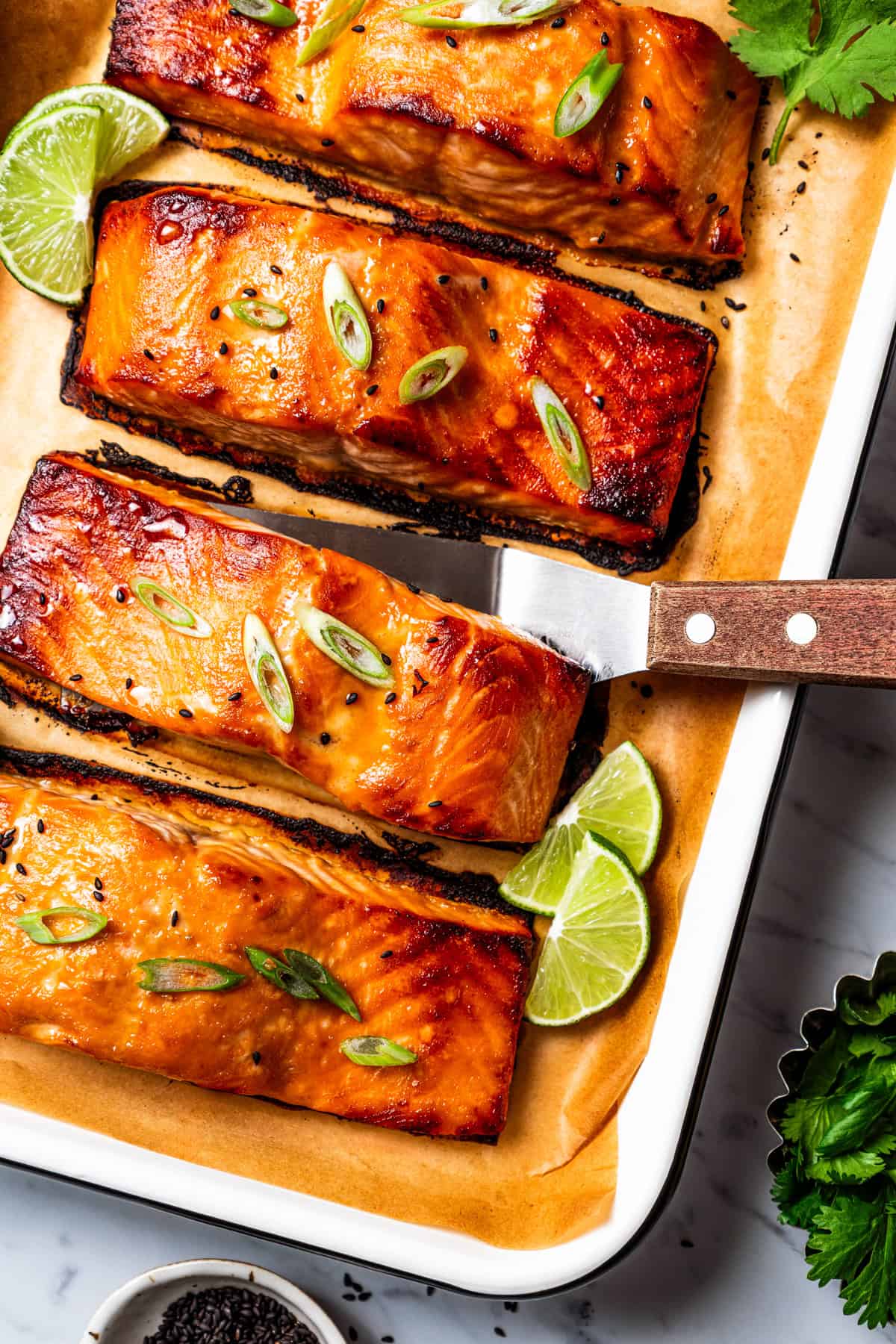
Tips and Variations
- Discard the used marinade. Once you’ve marinated the salmon, be sure to discard any leftover glaze. Do NOT reuse the marinade that’s come into contact with the raw fish.
- How to tell when salmon is cooked: Salmon is done when the internal temperature reaches 145ºF. Use an instant-read meat thermometer to be sure. If you’re going by eye, however, the salmon is cooked when it flakes easily with a fork, and the inside is opaque (pink, and not red).
- Use your air fryer. Prepare the miso salmon as directed and follow the cooking instructions for my air fryer salmon.
- Make it on the grill. This miso marinade is SO versatile. It’s perfect for basting the salmon fillets if you want to take this miso salmon recipe to the grill this summer. Or, use it to marinate the salmon for grilled salmon kebabs.
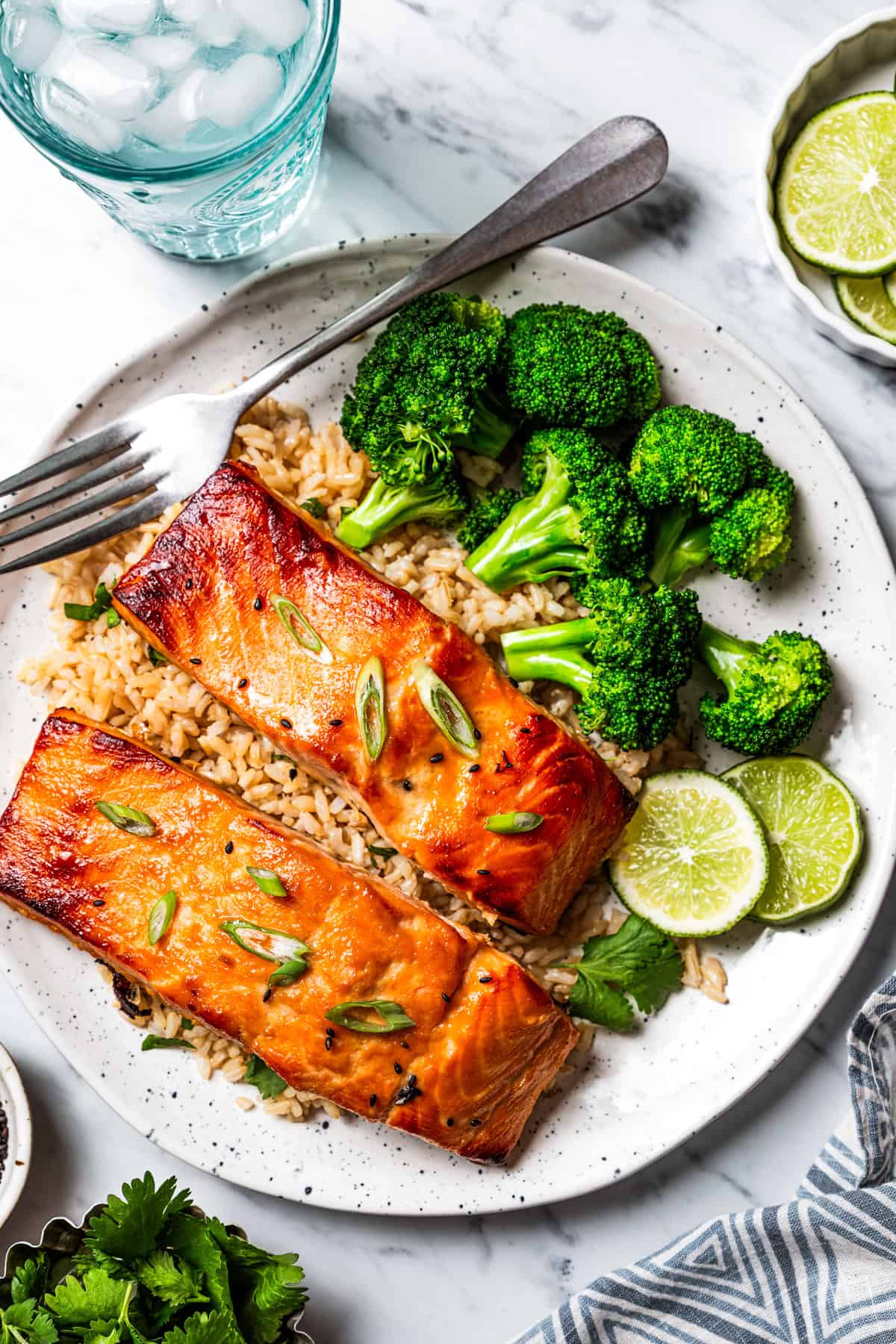
Pin this now to find it later
-
Prepare the marinade. Combine miso paste with mirin, soy sauce, maple syrup, and sesame oil in a bowl. Reserve 1 tablespoon of the marinade and set aside.
-
Marinate the salmon. Add salmon to the bowl and marinate it for 1 to 2 hours.
-
Prep. Preheat your oven to 375ºF. Line the baking tray with parchment paper. Remove the salmon from the marinade and discard the marinade. Place the salmon on the baking tray. Season the salmon with salt and pepper, to taste.
-
Bake the salmon. Bake the salmon for 15 minutes. Brush the salmon with reserved marinade and broil for 2 minutes. Serve the salmon while still warm.
- Sweetener options: Instead of maple syrup, you can use brown sugar.
- Cooked salmon: Please note that USDA recommends cooking fish to an internal temperature of 145ºF.
- Serving suggestions: Serve miso salmon with rice or noodles.
Calories: 295kcal | Carbohydrates: 7g | Protein: 37g | Fat: 13g | Saturated Fat: 2g | Polyunsaturated Fat: 5g | Monounsaturated Fat: 4g | Cholesterol: 94mg | Sodium: 1036mg | Potassium: 898mg | Fiber: 1g | Sugar: 2g | Vitamin A: 83IU | Calcium: 33mg | Iron: 2mg
Nutritional info is an estimate and provided as courtesy. Values may vary according to the ingredients and tools used. Please use your preferred nutritional calculator for more detailed info.
How to Make Miso Glazed Salmon
Speaking from experience, you’ll want to make this salmon over and over again. It’s THAT good and that easy. The main thing is to marinate the salmon long enough to really lock in the flavor. Here are the steps:
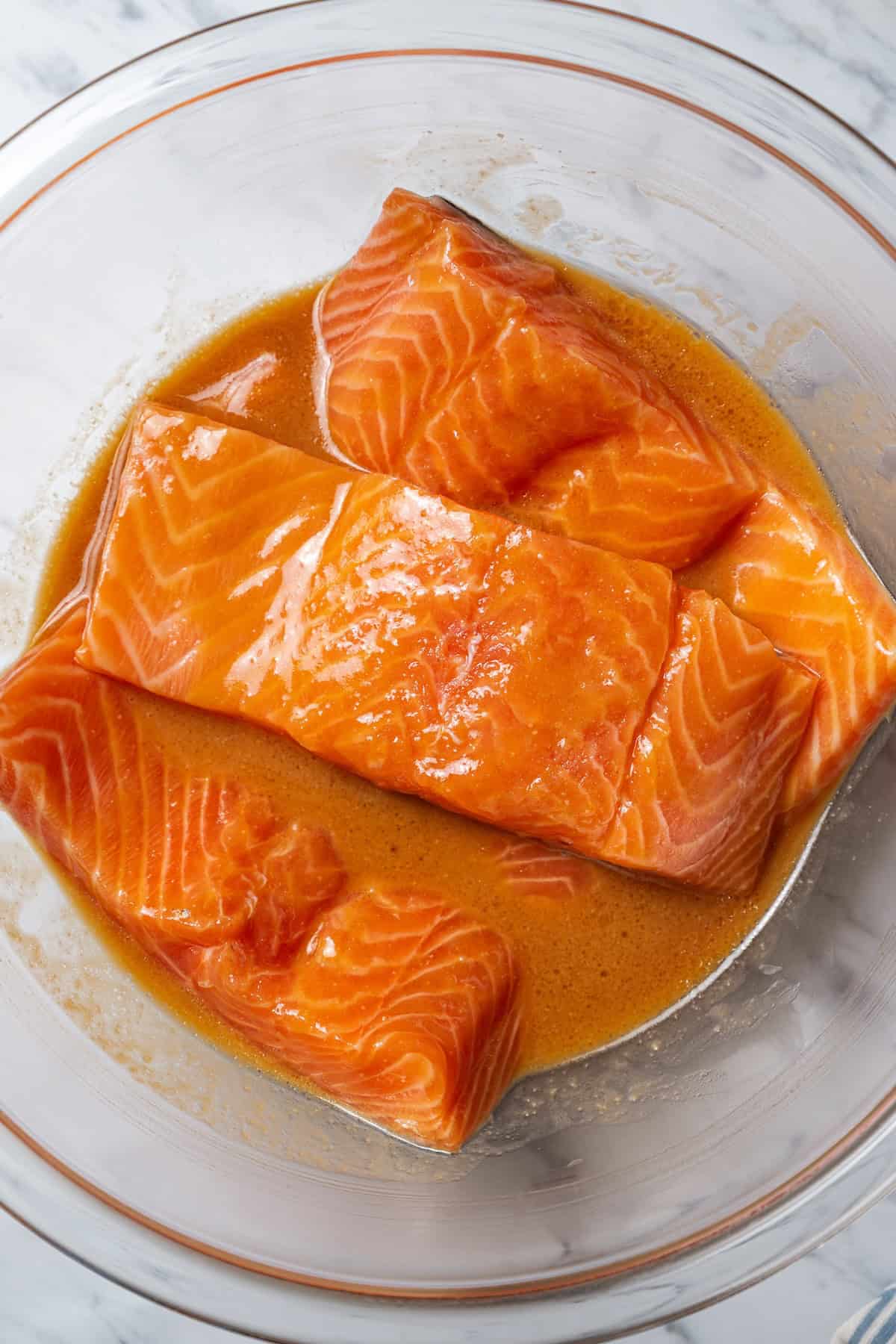
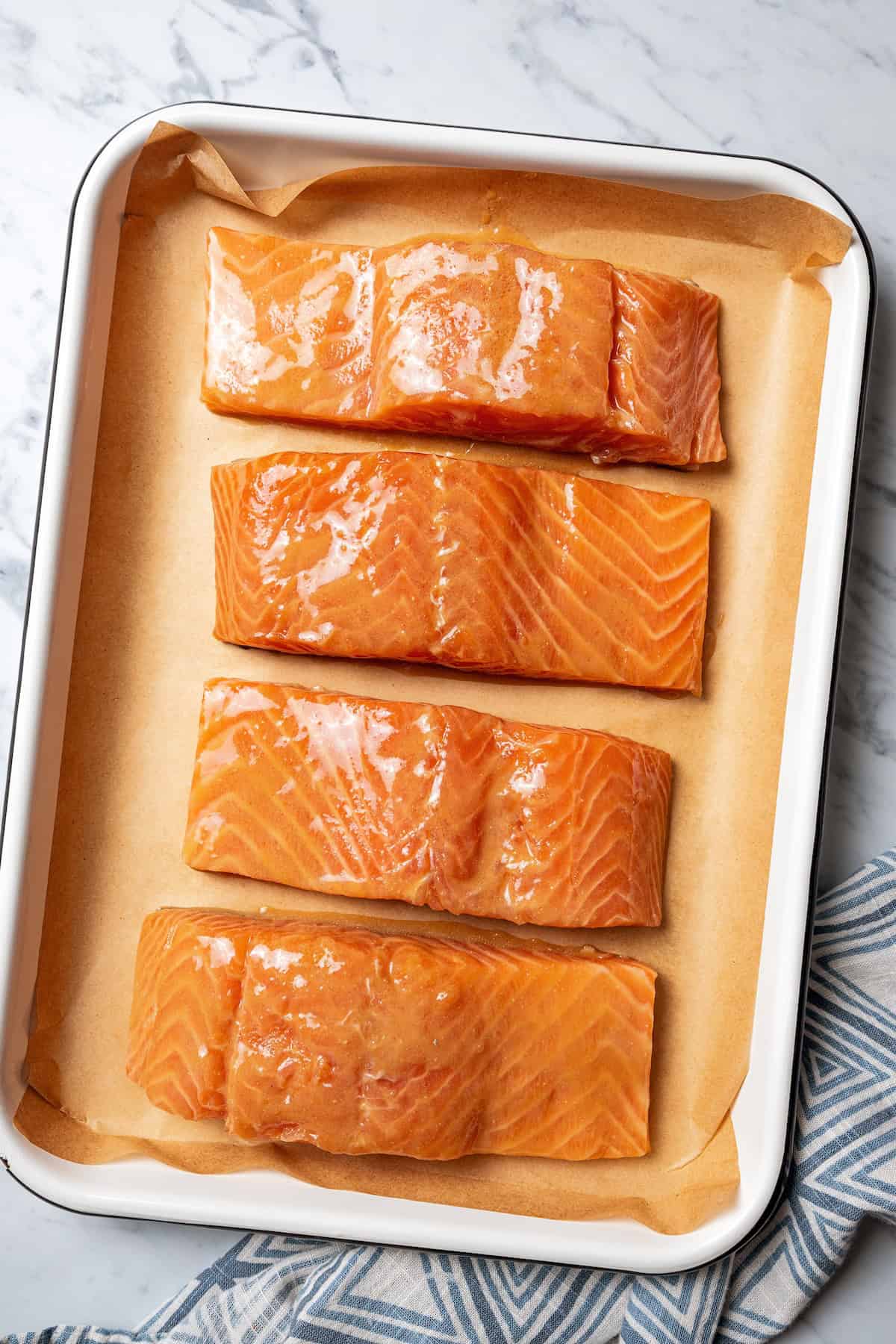
- Marinate the fish. Start by whisking the miso paste with the rest of the sauce ingredients. Set aside about a tablespoon of the marinade, and combine the rest with the salmon. Let that marinate for 1-2 hours.
- Prep for baking. While the oven preheats to 375ºF, line a baking pan. Take your salmon fillets out of the marinade and transfer them to the pan. Then, season with salt and pepper to taste.
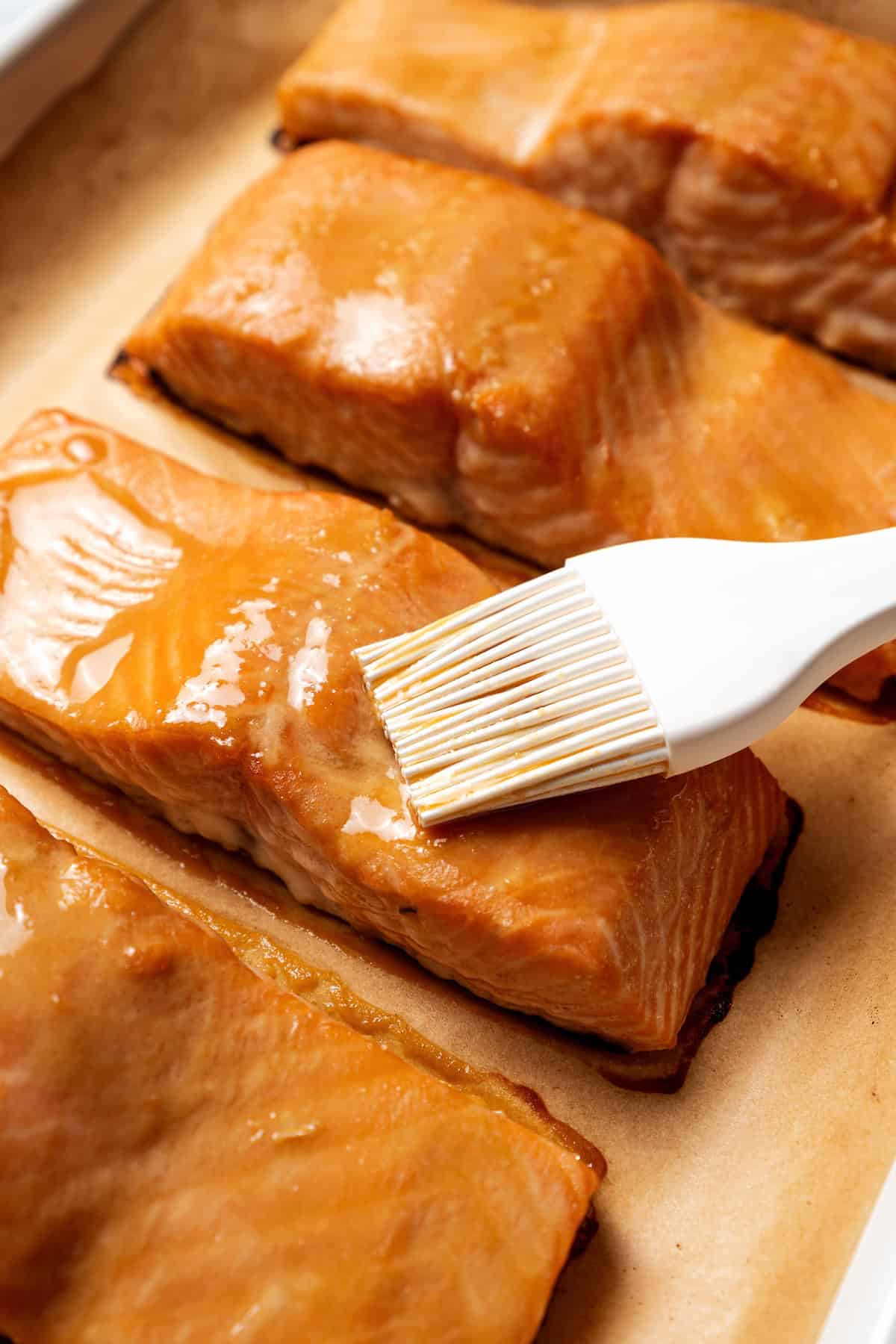

- Bake. This miso salmon goes into the 375ºF oven for 15 minutes. Use the reserved marinade to brush over the salmon afterward, before placing it under the broiler until it’s seared and caramelized. Serve your miso salmon warm with rice, or your choice of sides (see earlier in the post for ideas).
Storing and Reheating Leftover Salmon
- Refrigerate. Store any leftovers in an airtight container in the fridge for up to 3 days. Leftover miso salmon is delicious served cold in a salmon salad or poke bowls.
- Reheat. You can reheat salmon in the microwave or use the oven (the toaster oven even works perfectly here!).
- Freeze. To freeze the baked miso salmon, allow it to cool completely, and then wrap the fillets individually in plastic wrap, then place them in a freezer bag. Freeze the salmon for up to 2 months and thaw it in the fridge before reheating.
